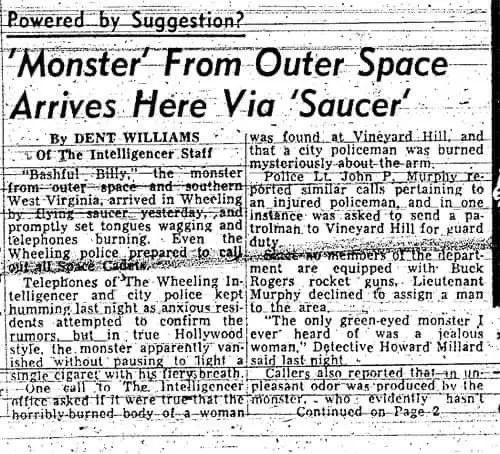By Charles Lear
 On September 12, 1952, a woman and six boys in the town of Flatwoods in Braxton County, West Virginia, reported that they’d had an encounter with a landed UFO and a strange creature. The woman, Mrs. Kathleen May, described the creature to a reporter as “a fire-breathing monster, ten-feet tall with a bright green body and a blood-red face.” She said the creature emitted an odor “like metal” that caused everyone to vomit for hours after the encounter. She added, “It looked worse than Frankenstein.” The witnesses all agreed that the figure had a red face with two openings like eyes that projected beams of greenish-orange light over their heads and that around the face there was a dark hood-like shape that came to a point like the ace of spades. The creature has become known as “The Flatwoods Monster.” By September 15, the case was reported in newspapers all over the country. It is likely that most readers are aware of this case, but many may not be aware of reports from nearby Wheeling, West Virginia, just a couple of days later. Read more
On September 12, 1952, a woman and six boys in the town of Flatwoods in Braxton County, West Virginia, reported that they’d had an encounter with a landed UFO and a strange creature. The woman, Mrs. Kathleen May, described the creature to a reporter as “a fire-breathing monster, ten-feet tall with a bright green body and a blood-red face.” She said the creature emitted an odor “like metal” that caused everyone to vomit for hours after the encounter. She added, “It looked worse than Frankenstein.” The witnesses all agreed that the figure had a red face with two openings like eyes that projected beams of greenish-orange light over their heads and that around the face there was a dark hood-like shape that came to a point like the ace of spades. The creature has become known as “The Flatwoods Monster.” By September 15, the case was reported in newspapers all over the country. It is likely that most readers are aware of this case, but many may not be aware of reports from nearby Wheeling, West Virginia, just a couple of days later. Read more
